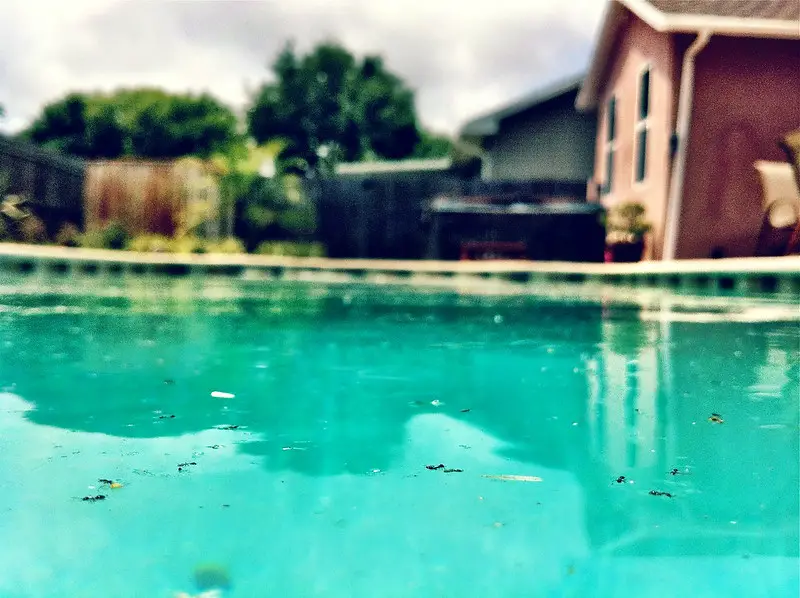Are you opening your pool after months or even years of neglect, but aren’t sure about how to deal with the swamp that it has become? Sure, you could call a pool restoration service, but you can also try cleaning it yourself to save money. It’s a good learning experience that can save you thousands of dollars over the years.
If you aren’t sure about how to clean a dirty pool, especially one that seems to be more swamp than pool, you might be surprised to learn that the steps you need to take aren’t much different than what you’d do just for general pool maintenance.
Essentially, you need to clean the pool surrounds, skim the water’s surface with a skimmer net to remove debris, add plenty of chlorine to shock the pool, vacuum up any remaining debris afterwards, and run the pool filter to clean up the pool water. You may also need to put some floc to clear up cloudy water and acid wash the pool walls if they are badly stained.
All of this is easier said than done, but if you keep reading on, I will go over how you can do each of these steps in more detail.
To drain or not to drain?
If your pool is green and has some debris in it, then that is hardly enough of a reason to drain your pool. You can easily fix it by removing the debris on the surface with a skimmer net, shocking the pool, filtering the water, and vacuuming it.
The bigger problem is if your swimming pool looks more like a bog that the scales start to tip towards just draining the pool, acid washing the surface or replacing the liner, and refilling it with freshwater.
In fact, if the pool has been left unused for years, you may want to simply hire a pool restoration service instead. There comes a point when you just need to start again with a clean slate.
Just know that draining the pool or hiring a pool restoration service are the more expensive options, and depending on the state of your pool water it may be far cheaper and easy enough to clean it on your own, but that’s up to you to decide.
How to clean dirty pool water without draining
Clean the pool surround
Before cleaning your pool, it’s important that you clean the surrounding area first. Otherwise if it is also dirty nearby, some of that dirt and debris can make its way into your pool after you’ve cleaned it and undo your hard work.
Plus, I don’t think you can call your pool clean if the surrounding areas are messy. Cleaning the pool and the pool deck go hand in hand, and is necessary so that your pool water doesn’t get contaminated again.
Remove as much large debris as you can
Now that you’ve already got your hands dirty, you can really get into the meat of the matter which is cleaning the pool itself.
So grab your skimmer net and skim the surface of the water to remove as much debris as you can. You want to remove as much of the dead leaves, branches, trash, or any other debris that has somehow found its way into your pool.
This can be harder if the water is extremely murky, so I advise you to do it slowly and carefully. This makes filtering the water much easier later on, otherwise you will have to replace the filter so many times.
Vacuum the pool
Use a long-handled pool brush to loosen any dirt that has accumulated on the bottom, and then vacuum it all up with the pool vacuum. After shocking, you may notice debris settled on the pool’s floor which you should vacuum again.
Shock the pool
To remove any organic debris and restore the pool water color to its original colorless state, you need to add plenty of chlorine into the pool.
Most pool experts recommend liquid chlorine because it mixes with the water more easily and is less likely to damage the pool walls.
Carefully read the product’s instructions for how much to add for a pool of your size. Generally speaking, you want the chlorine levels to be between 10 ppm and 30 ppm for maximum effectiveness.
Walk around the pool while pouring the shock so that it is evenly spread out.
Wait at least 24 hours and check the pool’s progress. You may need to shock the pool again if the water is still not cleared up.
Run the pump and pool filter
While shocking the pool, make sure the pump and pool filter are running at full speed. This helps the shock circulate around the pool more effectively, and also helps trap unwanted particles so that clean water returns to your pool.
If your pool water is really dirty, keep a close eye on the filter system and check that it does not malfunction, especially at the beginning. Expect to replace the filter several times over the course of this cleanup.
Put floc in the water
Even after shocking the pool, if you find that the water hasn’t cleared up and has a cloudy appearance, then you can add some flocculant to the water to fix this issue.
Floc will bind to dirt particles, creating a larger clump that will sink right to the floor so that it can easily be vacuumed up.
Test the water
Once the water looks clean and clear, use a pool test kit to ensure it is safe to swim in. Check that the pH is between 7.4 to 7.6, the free chlorine is between 1-3 ppm, and the alkalinity is 80-120 ppm. If the water chemistry is off, you’ll need to add more chemicals to balance it.
Photo Credit: Daniel Doyle (CC BY 2.0)

